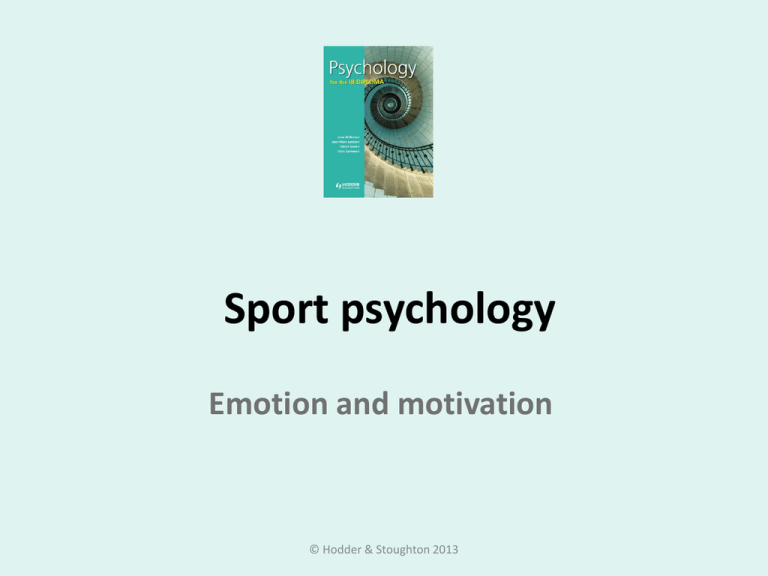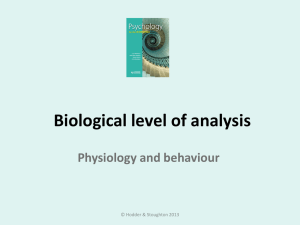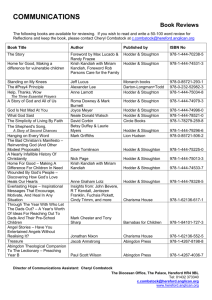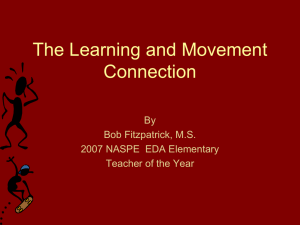Presentation
advertisement

Sport psychology Emotion and motivation © Hodder & Stoughton 2013 Activity Marco , a mountain runner, is about to start training for the Three Pigs race, his most important competition of the year. The race is four months away. Last year he ran well, but would like to run even faster this year. Marco isn’t very fit at the moment and is overweight by a few pounds. His main training session each week, which he times, is ‘the Hell of the North’ a 23 mile run over rugged mountains. Ultimately he needs to better last year’s fastest training run of 2 hours 10 minutes, but in his first training run he is only aiming for 3 hours, which he then intends to reduce by several minutes a week. © Hodder & Stoughton 2013 What is the thinking behind Marco’s preparation to try and run a fast time in this year’s Three Pigs race? Goal-setting • Ultimate (final) goals are known as productorientated or long-term goals, which are reached by achieving a series of processorientated or short-term goals. • Goals need to be measureable and realistic in order to create motivation. • Goals also need to be specific so it’s known whether they have been achieved, as well as being pre-determined so they can be specifically prepared for. • Athletes need to be involved in goal-setting to create ownership of a goal and inspire strong efforts to reach them. • Early short-term goals should be easy so they’re realized and thus increase confidence, commitment and motivation to reach the next goal. 1. In what ways does Marco’s preparation for the Three Pigs race fit the requirements of goal-setting described on the left hand side of this slide? 2. Make sure you identify what Marco’s product-orientated (long-term) and processorientated (short-term) goals are. © Hodder & Stoughton 2013 Command words: The language of the learning outcomes Learning outcome: Using one or more research studies, explain the role of goalsetting in the motivation of individuals • Exam questions will require candidates to give a detailed account of how goalsetting is related to motivation, with a requirement that this be done by reference to research studies that illustrate this relationship. • This could be achieved by highlighting the influence that goal-setting has upon factors that relate to motivational levels, such as confidence, commitment, effort and perseverance, as well as detailing the elements of goal-setting that influence motivational levels, such as long- and short-term goals and the need for goals to be realistic, specific and pre-determined as well as measureable. • Evaluation could centre on what research has informed us about the influence of goal-setting on motivation, such as open-ended goals not limiting excellent performances, as well as the practical applications of goal-setting to increase motivational levels and methodological issues associated with studying the area. © Hodder & Stoughton 2013 Theories of motivation in sport Drive theory • • Reversal theory Argues that as arousal increases, so does the level of performance, with arousal increasing to meet the perceived demands of a task. • Argues that individuals switch between different motivational styles, rather than having a fixed motivational style. • Changes in metamotivational state (alternative motivational states) during performance cause fluctuations in performance. • The theory perceives four domains (pairs of metamotivational states): The more learned a skill, the more high arousal will produce good performances. Inverted-U hypothesis • • Argues that as arousal increases, the level of performance increases up to an optimal point, after which increased arousal leads to a decline in performance. Simple tasks involving gross motor skills and little information processing tolerate more arousal before performance declines, while complex tasks involving fine motor skills and greater information processing tolerate less arousal before performance declines. • 1. Means–ends states (telic/paratelic) 2. Rule states (conformist/negativist) 3. Transaction states (mastery/sympathy) 4. Relationship states (autic/alloic) If the needs of a state an individual is in are met, positive emotions result © Hodder & Stoughton 2013 Command words: The language of the learning outcomes Learning outcome: Discuss theories relating arousal and anxiety to performance • Exam questions will require candidates to describe and evaluate explanations of how arousal and anxiety affect sporting performance. • Evaluations could be based upon the degree of research support for individual explanations, as well as their strengths and weaknesses, practical applications and related theoretical considerations, such as the psychological approaches upon which they are based. • A useful and high-level form of evaluation would be to compare and contrast individual explanations in order to draw out their relative strengths and weaknesses. © Hodder & Stoughton 2013 Emotion and motivation • Intrinsic motivation is the incentive that comes from the joy of participation in sport. • Extrinsic motivation is the incentive that comes from external factors like performing for money. • Deci (1971) took the pleasurable activity of doing puzzles and paid participants to complete them. When payment stopped, the activity became less pleasurable and effort decreased. 1. How might the findings of Deci’s study be explainable by reference to intrinsic and extrinsic motivation? 2. What do the findings tell us about the relationship between emotion and motivation? • When participants were rewarded instead with praise, effort and enjoyment increased when the reward ceased. © Hodder & Stoughton 2013











